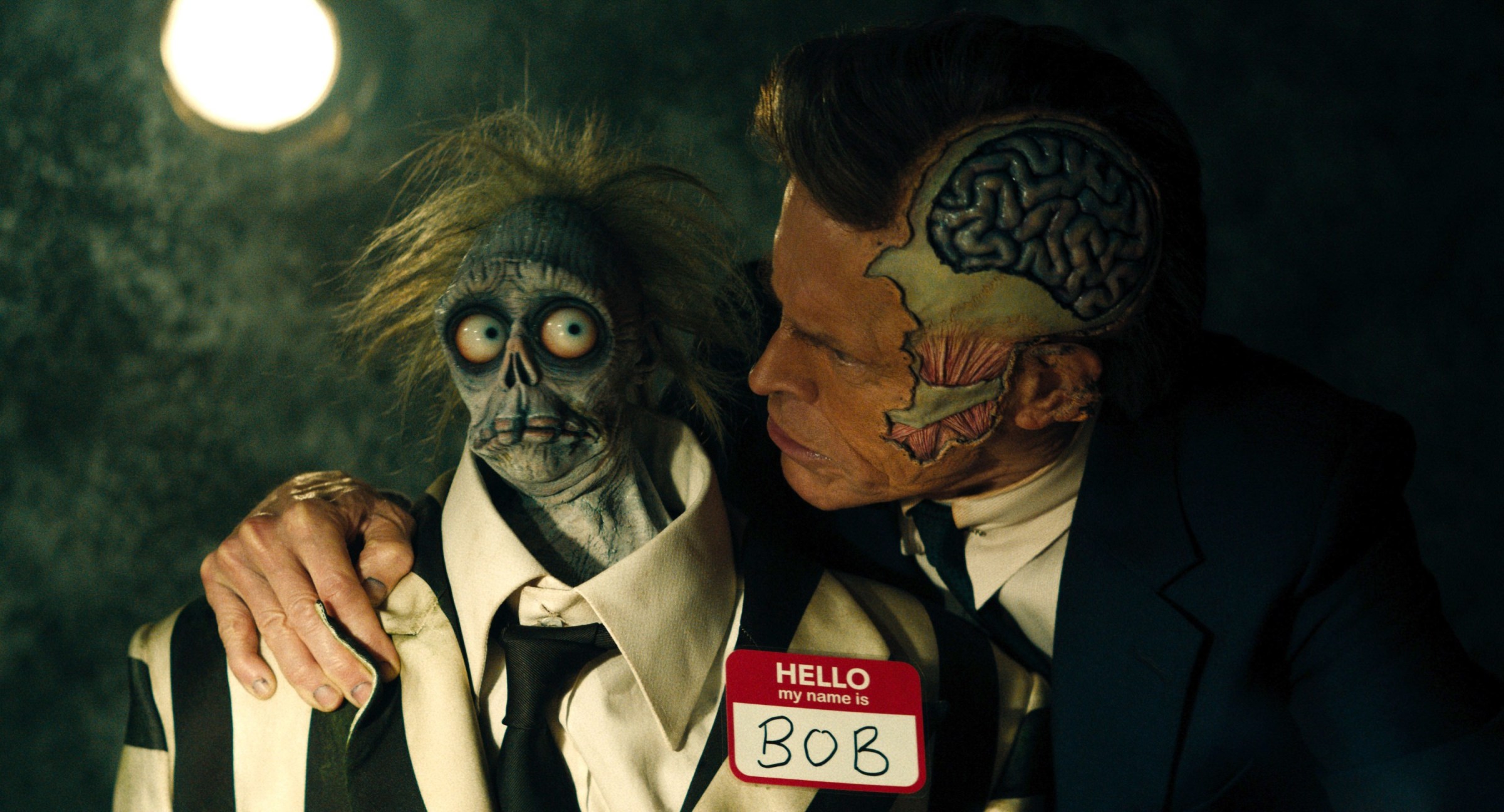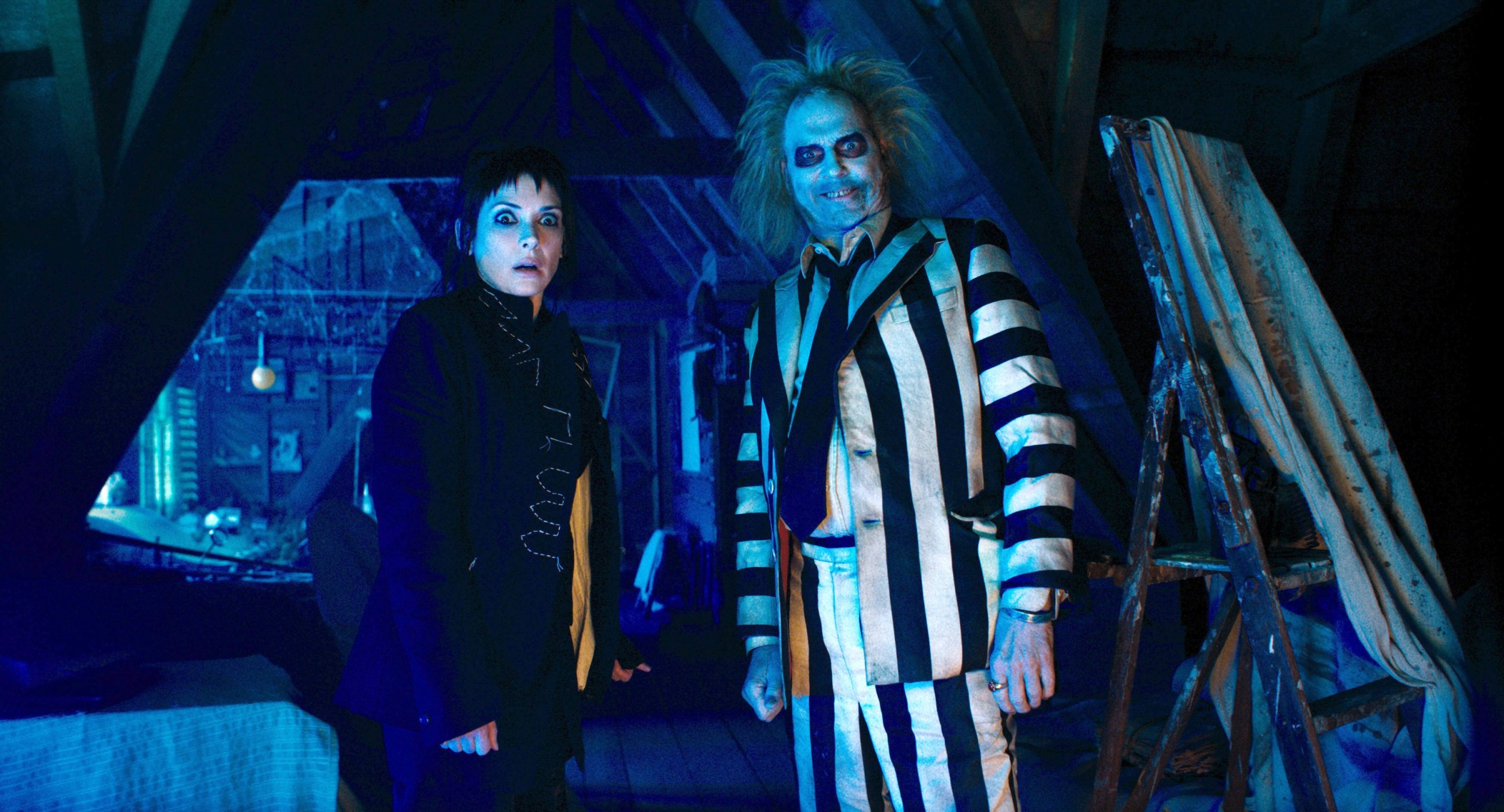Did the writers of Beetlejuice 2 throw in the towel halfway through the project?
“I swear, the afterlife is so randomJenna Ortega’s angsty teenage character Astrid Deetz growls, deep in the action of Tim Burton’s Beetlejuice Beetlejuice. It’s meant to be a standalone sentence, one of those, “Well, That happened!” / “Ooh, that is must hurt!” direct statements to the audience that stand in place of actual jokes. Instead, it comes across as if she’s saying the silent part out loud, laying out a mission statement for the entire film.
Beetlejuice Beetlejuice is essentially a series of chaotic visual gags and half-hearted character micro-arcs, all haphazardly strung together. It’s a showcase for Burton’s anarchic sense of humor and penchant for comedic caricature, a sequel built around nods to and echoes of the 1988 original. It’s another checkmark on the seemingly endless list of 2020s franchise installments that serve as belated victory laps for previous comedic triumphs, while dulling what was unique about those triumphs in the first place. But on its own, it’s not really a film. At best, it’s half a story—which is far more baffling than if it were pure, dizzying nonsense with no recognizable narrative at all.
The plot feels like the screenwriters (Small town And Wednesday co-writers Alfred Gough and Miles Millar) were only around for the first half of the project. The draft is certainly full of character specifics: Beetle juice Protagonist Lydia Deetz (Winona Ryder) has become a celebrated TV ghost hunter and secret off-screen pill popper, traumatized by her teenage experiences with Betelgeuse (Michael Keaton), the “bio-exorcist” (ghost? Or demon? This film says both) who terrorized Lydia’s family in the first film. She’s estranged from her angsty teenage daughter Astrid, who thinks Lydia spends too much time with her TV audience.
The space between them leaves room for three predators with their own agendas: Lydia’s oily manager Rory (Justin Theroux); local sad boy Jeremy (Arthur Conti), whose doe-eyed Dostoevsky fandom piques Astrid’s romantic interest; and, of course, Betelgeuse herself, who’s still obsessed with marrying Lydia, 30 years after they first met. All of these men want something from the women in this story, and all three disguise their ambition as romance. It would be a clever parallel if the whole structure didn’t fall apart as soon as it’s set up.
There’s a vague hint of emotion lurking beneath all the ensuing nonsense, tied up in the idea that Astrid and Lydia both want each other’s love and attention but can’t find common ground, given Astrid’s fierce skepticism about ghosts and Lydia’s determination to keep her daughter away from the world of the dead. The ways in which they both turn to other people and other pursuits to fill the gaps in their lives could be poignant, if it weren’t all so clearly a ploy to clutter the film with more antic characters – none of whom Burton and the writers really commit to more than a scene at a time.
Beetlejuice Beetlejuice is a hugely overstuffed film, even with some of the legacy characters awkwardly shoved off the stage. Lydia’s mother Delia (Catherine O’Hara) is still a central figure, but her husband Charles (Jeffrey Jones, whose career ended in a child pornography scandal) conveniently dies in a comical accident, depicted in stop-motion as an attempt to keep the actor off the screen. And original ghosts Adam and Barbara (Alec Baldwin and Geena Davis, who perhaps knew better than to take Burton’s phone call for this one) “found a loophole”, evaded their mandate to haunt Lydia’s house for the next 125 years, and disappeared from the story.
To fill their spots, the sequel boasts a number of new faces, including Willem Dafoe as Wolf Jackson, a dead action movie actor who sees his new job as a post-mortem cop as just another hammy performance, and Monica Bellucci as Delores, a stitched-together ghost who wants to devour Betelgeuse’s soul. As a visual design, Monica is a straightforward mix of Morticia Addams and Burton’s design for Sally in The Nightmare Before Christmas. As the film’s main villain, she’s an absolute nothing – a few poses, a few visual effects, and no sense of menace at all. She’s just a cold body running around in a maze with no entrance and no exit.
That’s the real problem in Beetlejuice Beetlejuice — Dolores, Rory, and Jeremy aren’t given enough screen time or story space to become meaningful or memorable. No one is. The first half of the film fades away in a flood of character tidbits that don’t matter and never come back. There’s no theme or thread to the bits and pieces, like Astrid’s obsession with climate change and political advocacy, or Delia’s latest major art project, which uses her body as a canvas.
A determined scholar of film theory might connect the ways in which the film’s three generations of women all attempt to regain control of their lives in a chaotic world—Astrid by focusing on her surroundings, Lydia by commodifying and trivializing her unwanted connection to the dead, Delia by taking her control over her own body literally. But none of these storylines is important to the story or, after their introduction, to the characters. The competing narratives crowd out and flatten each other. Eventually, they dissolve into a shared, collaborative way of marshaling the cast for a high-speed tour of the afterlife, where everyone runs around as if they were pull a Scooby-Doo door prankbut with more half-baked puns.
And then there’s Keaton, who reprises the role of Betelgeuse as if he’s never left it, and who weaves his way through a film that doesn’t allow for his larger-than-life performance. The first Beetle juice draws much of its energy from the tonal conflict between Baldwin and Davis’s lovably hapless, hopeless fish-out-of-water ghost characters and Keaton’s gleeful but kid-friendly malevolence, with Ryder caught in the middle as a classic Burton morbid-gothic oddball. There’s no sense of that conflict in what follows: the entire world has taken on the riotous, creepy tone of Keaton’s character, and every player in this story feels like a thinly masked version of the same person. There’s no hint of sweetness to it, except perhaps in the few spare moments when Astrid first meets Jeremy, and wonders if she’s finally found someone who understands her, however vaguely and broadly drawn.
There’s a real sense that the screenwriters left the building after the first hour of the film, leaving Burton to fill the rest of its running time with “Hey, remember the first movie?” references. The stop-motion sandworms are back. The afterlife-as-hell bureaucracy jokes are back. The broad-shouldered, shrunken-headed corpse is back, and now there’s a lot more of it. Betelgeuse is still doing his rear-view-exploding-face routine to scare people. A children’s choir sings Harry Belafonte’s “Banana Boat (Day-O)” in a setting that makes no sense as anything other than a reference. Once again, a big playback musical number is foisted on a group of unwilling participants. It’s the laziest way to put together a sequel: nostalgia with only minimal innovation in content, culminating in a climax that’s more or less the finale of the first film, with a few old names hastily crossed out and a few new ones added.
At his best, Tim Burton always excelled at finding a spark of genuine emotion at the root of his garishly comic nonsense: Edward Scissorhands’ desire to fit into a family safely and securely, Jack Skellington’s sheer joy in the fresh new excitement of Christmas, Ed Wood’s genuine love of cinema and desire to make something beautiful and lovable. Burton’s characters were notable for their unpredictable, gleefully gruesome idiosyncrasies and for the way they channeled the familiar feeling of wanting to be accepted without necessarily having to conform. But there’s no sign of sincerity anywhere in Beetlejuice Beetlejuiceand no trace of recognizable feeling. The whole film is an echo chamber of incidents. As Astrid notes, it is so random.
Beetlejuice Beetlejuice is now playing in theaters.


